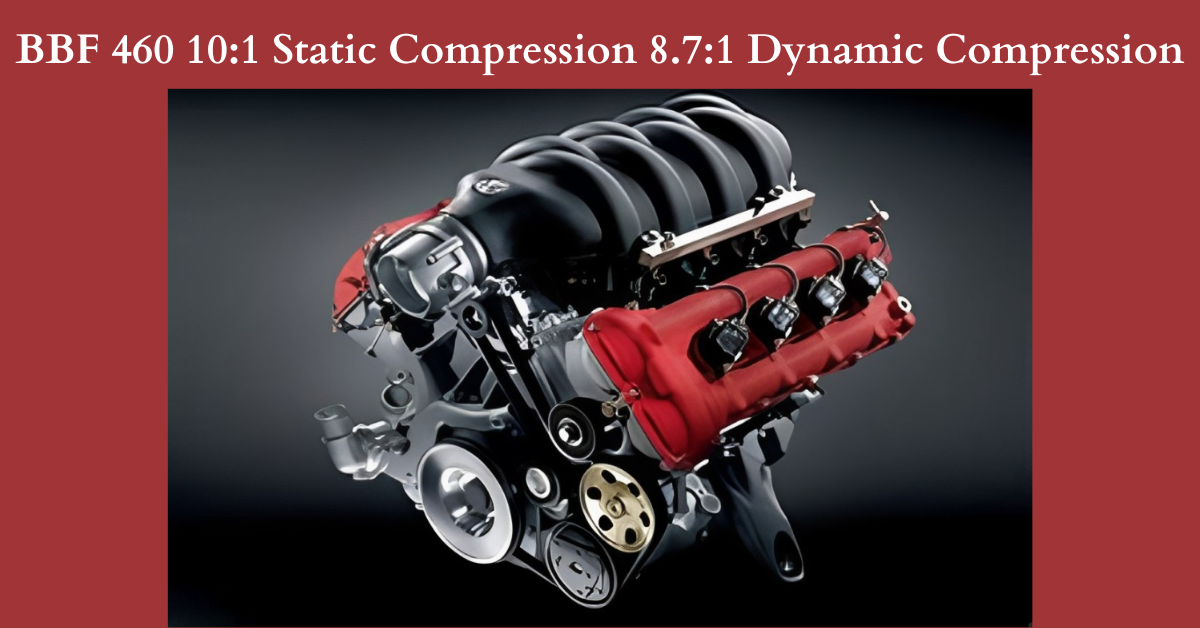BBF 460 10:1 Static Compression 8.7:1 Dynamic Compression: What It Means for Performance
When it comes to high-performance engines, understanding compression ratios is key to unlocking maximum power and efficiency. The bbf 460 results 10:1 static compression 8.7:1 dynamic compression, a renowned big-block Ford engine, is often at the center of discussions about engine performance.
What Is 460 Results 10:1 Static Compression 8.7:1 Dynamic Compression?
The bbf 460 results 10:1 static compression 8.7:1 dynamic compression is a big-block Ford engine, part of the 385-series family, known for its large displacement and high torque output. Typically, this engine finds its place in muscle cars, trucks, and even performance boats due to its robust design and power potential. The bbf 460 results 10:1 static compression 8.7:1 dynamic compression boasts a displacement of 460 cubic inches (7.5 liters), making it one of the more powerful naturally aspirated engines produced by Ford.
Static vs. Dynamic Compression
- Static Compression Ratio: This is the theoretical compression ratio calculated based on the engine’s physical dimensions (cylinder volume, piston displacement).
- Dynamic Compression Ratio: This is the actual compression ratio experienced by the air-fuel mixture during the engine’s operating cycle. It is influenced by several factors:
- Turbocharger Boost: The pressure increase from the turbocharger significantly impacts dynamic compression. As boost pressure rises, the effective compression ratio increases.
- Engine Speed: Higher engine speeds can affect the time available for the intake valves to close, influencing the amount of air inducted and thus affecting dynamic compression.
- Intake Valve Timing: The timing of the intake valve closure plays a crucial role. Early closure can trap more air, increasing dynamic compression, while late closure can allow some air to escape, reducing it.
- Cam Timing: The camshaft profile, specifically the intake valve opening and closing events, significantly influences airflow and dynamic compression.
How the bbf 460 Results 10:1 Static Compression 8.7:1 Dynamic Compression Compression Ratios Affect Performance
The combination of 10:1 static compression and 8.7:1 dynamic compression in the bbf 460 results 10:1 static compression 8.7:1 dynamic compression creates an engine that balances both power and reliability. Here’s how these ratios contribute to the overall performance:
Power Output
The 10:1 static compression provides a solid foundation for power. It allows for a more efficient burn of the air-fuel mixture, resulting in better torque and horsepower. This is especially noticeable in lower RPM ranges, where the engine can produce strong, smooth power delivery. On the other hand, the 8.7:1 dynamic compression slightly limits power in the higher RPM ranges but also provides a safer operational window. As the engine revs up, the dynamic compression ensures that the engine doesn’t knock or suffer from high pressures that could lead to engine damage.
Read Previous: Her Love Is a Kind of Charity Password
Fuel Efficiency and Engine Longevity
The high static compression ratio means the engine will make the most of the fuel it consumes, improving fuel efficiency at cruising speeds. However, this also places additional stress on components like pistons, rings, and valves. By limiting the dynamic compression, the engine experiences less strain at high RPMs, enhancing longevity and minimizing the risks of detonation and thermal damage.
Fuel Considerations
A 10:1 SCR engine will typically require premium gasoline (91–93 octane) to avoid detonation. The 8.7:1 DCR ensures the engine remains pump-gas friendly while delivering the performance expected from a high-compression big block.
BBF 460 Results 10:1 Static Compression 8.7:1 Dynamic Compression Build Considerations
When building a bbf 460 results 10:1 static compression 8.7:1 dynamic compression engine, choosing the right components is vital to maximizing performance and achieving the desired balance of static and dynamic compression. Some considerations include:
- Pistons: Choose pistons that match the desired static compression ratio. Flat-top pistons will give you the 10:1 ratio, while dished pistons will reduce it.
- Camshaft: As mentioned, camshaft selection can influence dynamic compression. Choose a camshaft that provides the right valve timing for your application.
- Cylinder Heads: Cylinder head design plays a major role in the compression process. Heads with larger combustion chambers reduce static compression, while smaller chambers increase it.
- Valves and Springs: Upgrading your valves and valve springs can allow for higher RPMs and improved engine reliability at those speeds.
FAQs
What is the BBF 460 engine?
The BBF 460 is a big-block Ford engine with a displacement of 460 cubic inches (7.5 liters). It’s known for its large displacement and high torque output, making it a popular choice for muscle cars, trucks, and performance boats.
What is the difference between static and dynamic compression ratios?
The static compression ratio (SCR) is the theoretical ratio based on cylinder volume at the top and bottom of the piston stroke. It represents the engine’s potential power capacity.
Why is the BBF 460’s compression ratio set at 10:1 static and 8.7:1 dynamic?
The 10:1 static compression provides a strong foundation for generating torque and horsepower, especially at lower RPMs. The 8.7:1 dynamic compression balances power and reliability by lowering the effective compression under higher RPMs, helping to prevent engine knock and improving engine durability.
What kind of fuel does the BBF 460 require?
The BBF 460 with a 10:1 static compression ratio typically requires premium gasoline (91–93 octane) to avoid detonation, but the dynamic compression ratio helps make it more forgiving on lower-quality pump gas.
Conclusion
The BBF 460 engine with its 10:1 static compression ratio and 8.7:1 dynamic compression ratio strikes an excellent balance between power, fuel efficiency, and engine reliability. Its design provides strong, smooth power delivery at low to mid RPMs, while also offering safety at higher RPMs by minimizing the risk of detonation. This makes the engine suitable for a variety of high-performance applications, whether it’s in a muscle car, truck, or performance boat.
Stay Tuned: Expressinsider!






